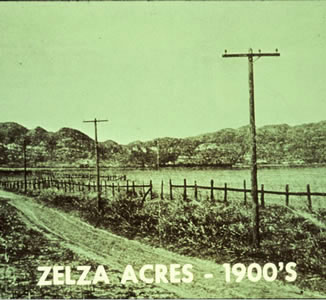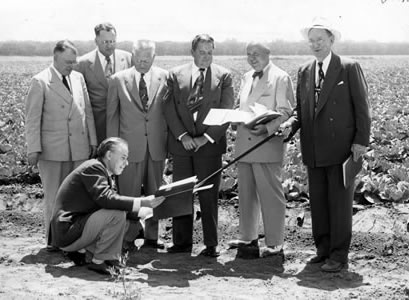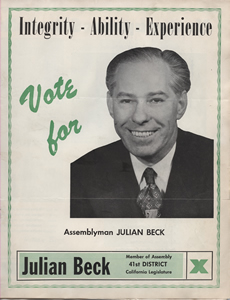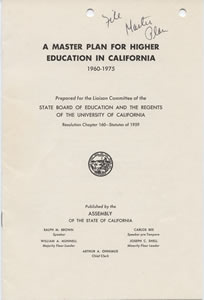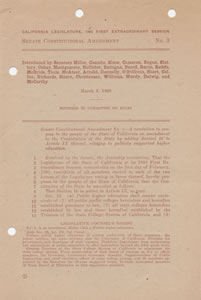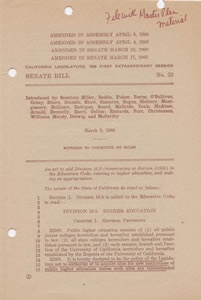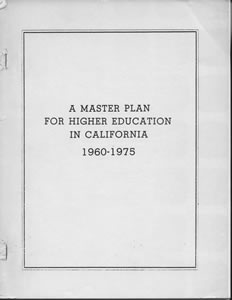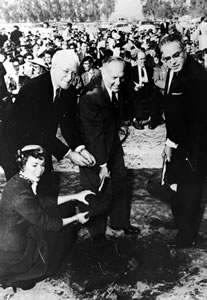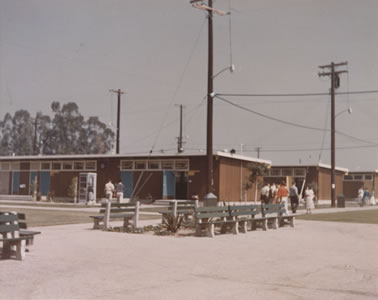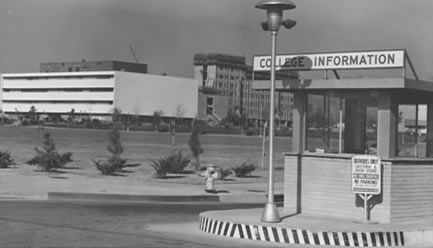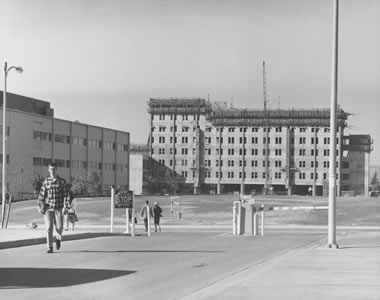Early Days
In many ways, California State University, Northridge began like many other Valley institutions: trees were cleared and foundations poured at sites that were once orange, lemon or avocado groves. Hand-lettered signs gave directions to temporary buildings connected by plank pathways. But before that humble start, there was a great deal of political maneuvering to ensure that a four-year college would even be located in the San Fernando Valley.
A Valley College
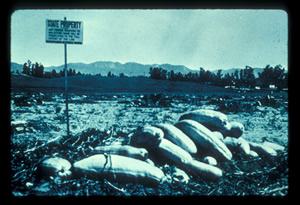
SQUASH FIELD WITH "STATE PROPERTY" SIGN, ca. 1955 CAMPUS SITE RIGHT AFTER IT WAS PURCHASED FOR $6,000.
In 1952, state officials had identified Baldwin Hills as the site of a new satellite campus for Los Angeles State College. In response, San Fernando Valley community and political leaders organized to overturn the legislation and ensure that a four-year college would be sited in the Valley. On December 21, 1954, advocates for a Valley four-year college hosted 23 legislators for dinner at the Brown Derby on Wilshire Boulevard. Armed with demographic projections, they pitched the San Fernando Valley as the only logical place for the next state college. The pitch worked. In 1955, state Assemblyman Julian Beck sent the legislation for approval to purchase land in the north San Fernando Valley for a new satellite campus to Los Angeles State College.
State officials check a proposed site for a public college in the San Fernando Valley , ca. 1952. Pictured left to right: Assemblyman Julian Beck (squatting); Senator Mayo; Senator Johnson; Division of Finance, Mr. Dean; Speaker Sam Collins; Real Estate Commissioner Watson; and Assemblyman Stewart of Pasadena. [Courtesy of the Judge Julian Beck Collection, Urban Archives Center]
VOTE FOR ASSEMBLYMAN JULIAN BECK, 1950s "Integrity - Ability - Experience" - front cover of election pamphlet for Julian Beck's successful campaign for the state assembly. ca. 1952 [Courtesy of the Judge Julian Beck Collection, Urban Archives Center]
Find more on Judge Julian Beck
The California Education Master Plan
The Master Plan, which was officially adopted into the California Education code with the Donahoe Act of 1960, called for the division of education into Research Universities, Teaching Colleges and Community College system “… the primary role of each of the three public segments and their relationship one with the other were so basic to their orderly development that these roles and these relationships ought to be part of the State Constitution.” As a member of the CSU system, CSUN was originally conceived as a “teaching college,” or training school for elementary school teachers.
Senate Bill 33 states that, “The State College System [which would eventually become the CSU system] shall be entirely independent of all political and sectarian influence and kept free therefrom in the appointment of its trustees and in the administration of its affairs.”
A Master Plan for Higher Education in California 1960-1975, February 1960
Explore California Planning for Higher Education
Construction
The official groundbreaking ceremony for the San Fernando Valley campus was on January 4, 1956. President of Los Angeles State College Howard McDonald, California Governor Goodwin Knight, and California Superintendent of Public Instruction Roy Simpson presided. The property for the 165-acre campus was purchased for $6,000. The first building to be completed in 1959 was South Library.
Before the permanent building was completed, the University Library was housed in a bungalow near what is now the University Student Union. Growth of services and collections required the Library to rent additional storage space in a meat market on Reseda Blvd, as well as in a hayloft in the stables at Devonshire Downs.
CONSTRUCTION OF SIERRA TOWER, 1963. The entire building complex upon completion would include the Sierra Tower, Sierra South and Sierra North (today Jerome Richfield Hall).
Explore Buildings and Construction
Early Days · Rapid Growth · Campus Life · CSUN in the Community · CSUN in the World

